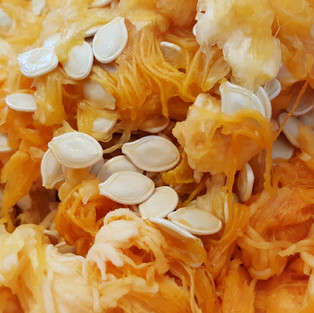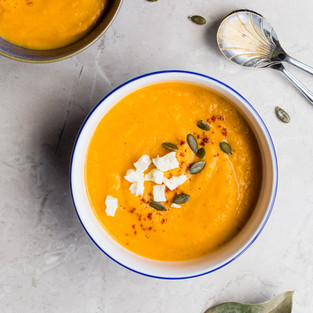Overview
The word pumpkin comes from the Greek word pepon, which means large melon.
Pumpkin originate from South America, specifically Mexico.
Pumpkins are part of the winter squash family, which also includes butternut, acorn, and Hubbard squash. In fancier words the Cucurbitacease family, which can be identified by their thick skin.
Pumpkins grow on a vine and are harvested during the fall season, They are also picked when mature.
Pumpkin is extremely versatile and great for both cooking and eating!
It's even used as decor, in and out of the home.
Pumpkins are the heart of the fall season and for a few holiday favorites, Halloween and Thanksgiving, it's a staple!
Pumpkin pie and carving pumpkins have become trademarks and make for great family traditions.

The Look
Pumpkins are relatively round in shape and come in various sizes.
They are typically orange in color, both in and outside. They get their color for the carotenoid pigments.
Not only can they vary in size, but also vary in flavor. Some varieties of pumpkins, called sugar pie pumpkins are raised to be sweeter, which make this pumpkin better for baking and cooking with.
Inside the thick shell of a pumpkin is the flesh and seeds, which are both edible as well.
When a pumpkin is first opened there is also a large amount of stringy pulp. Which will be extracted and tossed out, to get at the flesh and seeds, if consuming.
Nutrition
Vitamins A, and C
Also Vitamins E, and K
Carotenoids: Beta carotene, alpha-, and beta cryptoxanthin
Antioxidants: including antioxidant carotenoids lutein and zeaxanthin
Fiber
Manganese
Potassium
Magnesium
Benefits
Due to the high levels or antioxidants and carotenoids found within pumpkin, prevention of disease can be seen as a major benefit.
Also, carotenoids are extremely beneficial for eye health.
Vitamin A, just like the carotenoid aids in eye health and vision, but also gene expression, immune defense, maintenance of body linings, growth of bone, and cell development.
Vitamin E and C play a role as antioxidants and prevent oxidative damage.
Potassium, making pumpkin also great for heart health and electrolyte balance.
Pumpkin is a nutrient dense food, plus it's low in calorie, which can help promote weight loss.
These are just some of the primary benefits of pumpkin!
Serving Size
A serving of 1 cup cooked pumpkin contains about 40 calories
About 12 g of carbohydrates
About 1g of protein
About 0.1g of fat in each serving
There is also about 3 g of fiber per serving
Use and Cooking
Pumpkin is extremely versatile to cook with. It can be eaten in its more whole form or pureed down. One can make homemade puree or purchase canned pureed pumpkin. Canned pumpkin does tend to be a more convent method. If using canned pumpkin make sure to select 100% pumpkin, with no added sugars.
To make home made pumpkin puree, pre heat an oven to 350 degrees F. Cut a pumpkin into quarters and drizzle each quarter with olive oil. Place the quarters on a lined baking sheet with the flesh side up. Bake in the oven till the flesh is tender and can be scooped out. Scoop out the pumpkin flesh and place in a food processor. Blend until smooth, or the desired pureed texture has been met.
When looking to use fresh pumpkin, look for ready to go cooking pumpkins or pre cut pumpkin at a local grocery store, or even head to a pumpkin patch!
When cooking with pumpkin, it's best to select smaller pumpkins. Smaller pumpkins tend to have better flavor. Obviously, look to select a pumpkin with minimal damage to them.
Also, look for a more dull orange colored pumpkin. A very shiny pumpkin usually indicates that it was picked too soon.
One of the most common ways we use and cook with pumpkin is for pumpkin pie! But there are a variety of ways to utilize it!
Add pumpkin to make soup, vegetable roasts, stews, salads, oatmeal, smoothies, and much more!
Storing
If you are using canned pumpkin, store the can as any other canned product. Once the can has been opened, sore the remaining pumpkin in an air tight container in the fridge. Stored pumpkin in the fridge will hold up for about 4-5 days in the fridge. Leftover canned pumpkin will also hold up in an air tight container in the freezer, this will last for about 3 months.
To store a whole pumpkin, place it in a cool, darker place. Avoid damp areas. Any extra whole pumpkin pieces can also be place in the fridge for 3-4 days in an air tight container.
Recipes

Check out how to make the LF No Bake Pumpkin Cheesecake, that is sure to win over the table! Another fun way to incorporate pumpkin is to make home made Pumpkin Granola.
Looking to make some pumpkin seeds? Start by collecting and cleaning all the seeds from the pumpkin. Make sure to dry seeds completely. Pre heat the oven to 300 degrees F. While oven is pre heating in a bowl toss together seeds, a punch of salt and about a tablespoon of olive oil. Place coated seeds on a baking sheet, spread evenly around in a single layer. Bake in the oven for about 30 minutes. Take baking sheet out of the oven, mix seeds around, seeds can go back in the oven for an additional 20 minutes if needed. Just keep an eye out for a golden brown seed! Optional: spice up the pumpkin seeds with a variety of sweet and savory seasonings.
The flowers of the pumpkin are also edible. Many often will use as garnishes or batter and fry them up!















Comments